People get all heated up when the subject of GMOs (genetically-modified organisms) come up. People tend to get bent out of shape one way or the other, just like the vaccine debate that has seen people aggressively troll each other on the internet, in some cases insisting that parents that don’t vaccinate should get their kids taken away from them (because that’s the solution here, more innocent kids in the system).
As a holistic nutritionist, it’s not hard to guess which side of the GMO argument I’m on. It wasn’t always like this though, there was a time when food was just something I ate and I just put my trust and faith that it was not going to harm me. I even ate a grapple once!
Now before you get all skeptical and roll your eyes and scroll to the next article, I ask you to open your mind. Even if you're pro-GMO, I don’t think there is any denying the possibility of negative impacts on our environment and our health.
Many of the studies that have been done on GMOs are only short term and funded by the companies that are selling genetically-modified products. Many of these are not peer-reviewed and most of the data was not released to the public. Sounds a little bit dodgy.
What is a GMO?
The World Health Organization defines GMOs as organisms in which the genetic material has been altered in a way the does not occur naturally. What does that mean? To put it simply, it’s like taking pig DNA and adding it to a strawberry. Gee I wonder what could go wrong when messing with these two very different genetic materials? Maybe nothing, maybe disaster.
Whatever side of the debate you are on, we can all agree the business model and marketing of the companies that have created GMOs is genius. By patenting their seeds and altering them to include “terminator genes” that make second-generation seeds sterile, companies can create a product that guarantees repeat customers, which is horrifying and kinda brilliant.
Popular GMO practices
Herbicide resisters. This makes the plant immune to weed killers like Monsanto’s Roundup by altering the plant’s DNA. Herbicides are normally sprayed sparingly onto crops and are able to kill any of those pesky unwanted weeds while leaving the crop unharmed and able to thrive. Sounds pretty good on the farmer's side of things, unfortunately when these foods are consumed by us, they are still soaked in poison. Just this week, scientists from the World Health Organizationconcluded that Roundup is likely carcinogenic. We are eating this, and we are getting sick and ruining our environment.
Pesticide producers.A gene from a natural bacteria is injected to the plant DNA to produce toxins that kill insects. The obvious appeal here is that farmers would have more of a yield because they would not have to deal with bugs feasting on their crops. If it’s killing bugs, isn’t it safe to say that it may also have some sort of poisonous reaction in humans? Last time I checked humans were not immune to poison, even if it takes a long time slowly killing us.
The biggest argument I hear on the pro GMO side is how these products have the potential to end world hunger, since pesticide- and herbicide-resistant crops help farmers increase yield and decrease cost. Unfortunately this can lead to an increase in herbicide use and promote the development of herbicide resistant weeds leading to damaged biodiversity on farms and health concerns like allergies. In fact, food allergies have increased significantly since the introduction of GMO foods on the market. Coincidence? Probably not! Just sayin’, kind of a big deal, folks.
Many European countries have taken the step of banning certain GMO seeds, while more than 60 countries require mandatory labelling of GMO foods, but Canada isn’t one of them. Feel free to make up your own mind, and if you think it’s safe, consume away, But for the rest of us that aren’t into it, let’s have a choice at the very least, let’s label that shit.
Recipe: Organic Vinaigrette Coleslaw
Ingredients (organic and local is always best if you can!)
1/2 head of cabbage-shredded or chopped
2 medium shredded carrots
3 radishes, thinly sliced
1 clove crushed garlic
1 apple, sliced very small
1 pinch of Himalayan salt and pepper
1 tbsp olive oil
2 tbsp apple cider vinegar
Directions
Mix together in a bowl. Let sit in fridge for 15 minutes before eating.



